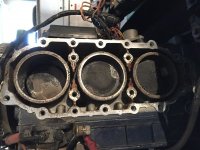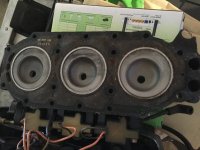First time poster here. I apologize for anything I can't explain properly.
I have an 82 Evinrude 75hp 3cyl on a 2002 bass tracker 17footer.
Took out last 3 times and a would top out at 5200rpm. Fish for a bit and it would usually fire back up quickly. I did get stuck 1 time and waited it out and tried again. I thought it was mostly the new throttle cable that I replaced and needed tinkered with to find the magic spot for it. Messed with it and got it to a level where it would start no problem after stopping. It would idle at 1400rpm.
Today on the water started just fine. Ran about 30mins. Fished for 45. Moved to next spot as I was WOT, I saw my RPM drop to 420rpm and speed dump from 34mph to 22mph. We pulled over and I thought it was the throttle cable. Messed with that awhile but did not fix the problem. I also noticed when going from forward to neutral, the rpm would rev to 300rpm and stay. I would have to open the motor and manually push the throttle bar ??? Back to idle.
i went the rest of the day like this and it became pretty difficult to start if the motor rested for a period of time.
I looked around and came up with the following to trouble shoot with. Any direction is greatly appreciated!
1- check spark on plugs
2- squeeze fuel ball when WOT to see if rpm boost
3-check carbs possible sticking or need rebuild
4- check coils (CDI ???)
5- any other suggestions are appreciated
I have an 82 Evinrude 75hp 3cyl on a 2002 bass tracker 17footer.
Took out last 3 times and a would top out at 5200rpm. Fish for a bit and it would usually fire back up quickly. I did get stuck 1 time and waited it out and tried again. I thought it was mostly the new throttle cable that I replaced and needed tinkered with to find the magic spot for it. Messed with it and got it to a level where it would start no problem after stopping. It would idle at 1400rpm.
Today on the water started just fine. Ran about 30mins. Fished for 45. Moved to next spot as I was WOT, I saw my RPM drop to 420rpm and speed dump from 34mph to 22mph. We pulled over and I thought it was the throttle cable. Messed with that awhile but did not fix the problem. I also noticed when going from forward to neutral, the rpm would rev to 300rpm and stay. I would have to open the motor and manually push the throttle bar ??? Back to idle.
i went the rest of the day like this and it became pretty difficult to start if the motor rested for a period of time.
I looked around and came up with the following to trouble shoot with. Any direction is greatly appreciated!
1- check spark on plugs
2- squeeze fuel ball when WOT to see if rpm boost
3-check carbs possible sticking or need rebuild
4- check coils (CDI ???)
5- any other suggestions are appreciated




